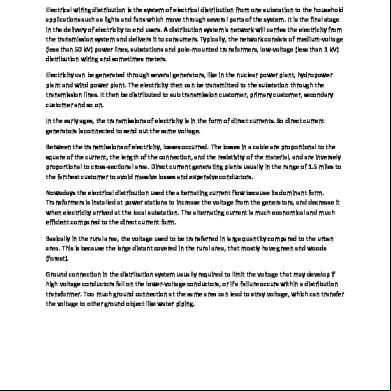Conclusion And Recommendations3 6f542t
This document was ed by and they confirmed that they have the permission to share it. If you are author or own the copyright of this book, please report to us by using this report form. Report 2z6p3t
Overview 5o1f4z
& View Conclusion And Recommendations3 as PDF for free.
More details 6z3438
- Words: 989
- Pages: 2
CONCLUSIONS AND RECOMMENDATIONS On this experiment, several tests were used to analyze the hydroxyl group, the functional group found in alcohols. Alcohols were identified as primary, secondary or tertiary according to the tests performed. The first test conducted is the solubility test where water is the solvent. Test compounds used were ethanol, n-butyl alcohol, sec-butyl alcohol, tert-butyl alcohol, benzyl alcohol, glycerol and phenol. It was found that only ethanol, sec-butyl alcohol, tert-butyl alcohol and glycerol were soluble in water. This is because hydrogen bonding between these molecules and water are high enough compared to other alcohols making it soluble in water. There are also tests performed to differentiate alcohols from phenols. These were acidity/basicity test, sodium metal test, acetyl chloride test, Lucas test, oxidation reaction test, iodoform test, bromine water test, and ferric chloride test. In the acidity/basicity test, it was found that phenol is more acidic than ethanol. These can also be seen when litmus paper was tested on both compounds. The reason for this was the concept of resonance. When phenol was deprotonated, it still has stable conjugate base making it more acidic compared to ethanol. Moreover, phenol produced more resonance structures than that of ethanol. In sodium metal test, phenol was the quickest to react followed by n-butanol, sec-butanol, and lastly tertbutanol. Phenol is the most acidic out of these compounds. The branchings of the carbon bearing the hydroxyl group affects the rate of the reaction due to steric effects, making the the tert-butanol least reactive and n-butanol most reactive out of these saturated alcohol isomers. In acetyl chloride test, esters are formed when alcohols react with acetyl chloride. The presence of an ester is indicated by a formation of a layer in the solution. Since the test compounds reacted, the carbon bearing the hydroxyl group is either primary or secondary.
In Lucas test, no reaction were formed when the test compounds reacted with the Lucas reagent. A possible reason for this was the contamination of the reagent upon usage. Theoretically, alcohols that reacted with Lucas reagent within 5 minutes can be classified as tertiary then secondary alcohols reacted within 5-10 minutes. In oxidation test, the test compounds were oxidized using 10% potassium chromate added in dilute sulfuric acid. Tert-butanol did not show any presence of reaction since it cannot be further oxidized. Ethanol was oxidized into ethanal and isopropanol oxidized into acetone. It can be said that only primary and secondary alcohols are reactive in this test. In iodoform test, a formation of yellow precipitate was observed on the test compounds when reacted with iodine in potassium iodide and sodium hydroxide. The product is a sodium ethanoate for isopropanol and a sodium formate for ethanol. The yellow precipitate is the iodoform. Since they reacted, it means a methyl group can be found attached on the carbon bearing the hydroxyl group. In the bromine water test, phenol produced white precipitate and benzyl alcohol changed from colorless to brown. Since the phenol reacted, it means that the aromatic ring is activated while benzyl alcohol is weak activator. The last test performed was the ferric chloride test. Phenol was reactive producing black solution while benzyl alcohol was unreactive. This is an excellent test for differentiating alcohols from phenols. To further assess these tests, several compounds were given and these tests were to distinguish them apart. The first set was the isomeric five-carbon saturated alcohols. Tertiary alcohols will react in Lucas reagent within 5 minutes of reaction while the other isomers will have slower reaction time. The primary and secondary alcohols can be oxidized into ester when reacted with acetyl chloride test while tertiary alcohol will not react. Primary and secondary alcohols will be oxidized into carboxylic acid and ketone, respectively while tertiary alcohols will have no reaction when tested with potassium dichromate.
If allyl alcohol and propanol were to be reacted with Lucas reagent, allyl alcohol will react faster than propanol because the carbocation formed on the former is resonance stabilized.
O-cresol and anisole can be distinguished using sodium metal test and acetyl chloride test. Only ocresol will react with both tests while the anisole will not.
Benzyl alcohol and cyclohexanol can be differentiated using Lucas test and sodium metal test. In Lucas test, benzylic alcohol is reactive due to its resonance stabilized carbocation. In sodium metal test, cyclohexanol will react faster than benzylic alcohol since the former is a secondary alcohol.
To differentiate benzyl alcohol from anisole, sodium metal test and acetyl chloride test can be used. Only benzyl alcohol will react with both tests while the anisole will not.
To distinguish benzyl alcohol from phenol, bromine water test and ferric chloride test can be used. Phenol will not decolorize but the benzyl alcohol will decolorize into brown when reacted with bromine water. In ferric chloride test, phenol will form black iron complex while benzyl alcohol will be unreactive. Differentiating cyclohexanol from 1methycyclohexanol will use sodium metal, acetyl chloride, Lucas, oxidation and iodoform test. In sodium metal test, cyclohexanol will react faster than 1-methylcyclohexanol because cyclohexanol is secondary alcohol. In acetyl chloride, cyclohexanol will form a layer while 1-methylcyclohexanol will not. In Lucas test, 1-methylcyclohexanol will react faster than cyclohexanol. In oxidation test, chromic acid will oxidized cyclohexanol while 1-methylcyclohexanol will not react because it is tertiary alcohol. Lastly, in iodoform test, only 1-methylcyclohexanol will form iodoform or the precipitate.
The objectives of this experiment were met which were to examine and differentiate the properties of alcohols and phenols and to visualize the characteristic reactions of alcohols and phenols. It can be recommended that the reactions must be observed for a longer period of time since the other reactions were not totally completed. It can be recommended that reactions can be performed only if the reagents used are free from any contaminations. These can be done by performing the experiment under the fumehood and avoiding exposure to air. Any reactions using contaminated reagents will induce erroneous results.
In Lucas test, no reaction were formed when the test compounds reacted with the Lucas reagent. A possible reason for this was the contamination of the reagent upon usage. Theoretically, alcohols that reacted with Lucas reagent within 5 minutes can be classified as tertiary then secondary alcohols reacted within 5-10 minutes. In oxidation test, the test compounds were oxidized using 10% potassium chromate added in dilute sulfuric acid. Tert-butanol did not show any presence of reaction since it cannot be further oxidized. Ethanol was oxidized into ethanal and isopropanol oxidized into acetone. It can be said that only primary and secondary alcohols are reactive in this test. In iodoform test, a formation of yellow precipitate was observed on the test compounds when reacted with iodine in potassium iodide and sodium hydroxide. The product is a sodium ethanoate for isopropanol and a sodium formate for ethanol. The yellow precipitate is the iodoform. Since they reacted, it means a methyl group can be found attached on the carbon bearing the hydroxyl group. In the bromine water test, phenol produced white precipitate and benzyl alcohol changed from colorless to brown. Since the phenol reacted, it means that the aromatic ring is activated while benzyl alcohol is weak activator. The last test performed was the ferric chloride test. Phenol was reactive producing black solution while benzyl alcohol was unreactive. This is an excellent test for differentiating alcohols from phenols. To further assess these tests, several compounds were given and these tests were to distinguish them apart. The first set was the isomeric five-carbon saturated alcohols. Tertiary alcohols will react in Lucas reagent within 5 minutes of reaction while the other isomers will have slower reaction time. The primary and secondary alcohols can be oxidized into ester when reacted with acetyl chloride test while tertiary alcohol will not react. Primary and secondary alcohols will be oxidized into carboxylic acid and ketone, respectively while tertiary alcohols will have no reaction when tested with potassium dichromate.
If allyl alcohol and propanol were to be reacted with Lucas reagent, allyl alcohol will react faster than propanol because the carbocation formed on the former is resonance stabilized.
O-cresol and anisole can be distinguished using sodium metal test and acetyl chloride test. Only ocresol will react with both tests while the anisole will not.
Benzyl alcohol and cyclohexanol can be differentiated using Lucas test and sodium metal test. In Lucas test, benzylic alcohol is reactive due to its resonance stabilized carbocation. In sodium metal test, cyclohexanol will react faster than benzylic alcohol since the former is a secondary alcohol.
To differentiate benzyl alcohol from anisole, sodium metal test and acetyl chloride test can be used. Only benzyl alcohol will react with both tests while the anisole will not.
To distinguish benzyl alcohol from phenol, bromine water test and ferric chloride test can be used. Phenol will not decolorize but the benzyl alcohol will decolorize into brown when reacted with bromine water. In ferric chloride test, phenol will form black iron complex while benzyl alcohol will be unreactive. Differentiating cyclohexanol from 1methycyclohexanol will use sodium metal, acetyl chloride, Lucas, oxidation and iodoform test. In sodium metal test, cyclohexanol will react faster than 1-methylcyclohexanol because cyclohexanol is secondary alcohol. In acetyl chloride, cyclohexanol will form a layer while 1-methylcyclohexanol will not. In Lucas test, 1-methylcyclohexanol will react faster than cyclohexanol. In oxidation test, chromic acid will oxidized cyclohexanol while 1-methylcyclohexanol will not react because it is tertiary alcohol. Lastly, in iodoform test, only 1-methylcyclohexanol will form iodoform or the precipitate.
The objectives of this experiment were met which were to examine and differentiate the properties of alcohols and phenols and to visualize the characteristic reactions of alcohols and phenols. It can be recommended that the reactions must be observed for a longer period of time since the other reactions were not totally completed. It can be recommended that reactions can be performed only if the reagents used are free from any contaminations. These can be done by performing the experiment under the fumehood and avoiding exposure to air. Any reactions using contaminated reagents will induce erroneous results.










